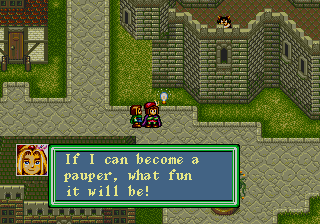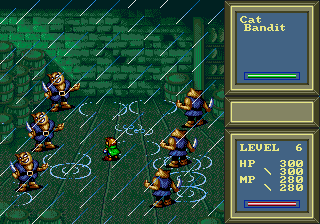 Genesis fans, rejoice. No longer must you envy the Atari and Colecovision communities for their excellent homebrew games. No longer must you long for someone to pick up the torch for your long-dormant console of choice. Those days are over! No, this fall you will be treated to a full-fledged release, complete with clamshell case, insert, and manual. Beggar Princewill be the first new Genesis game released in the U.S. since 1998, thanks to Brandon Cobb and the great folks over at the Super Fighter Team. Their commitment has been unwavering, and they’ve assembled a top notch team to ensure both quality and faithfulness to the original C&E Inc. product. This no ordinary homebrew game, folks. This is the real deal, with all the bells and whistles you’d expect from a top quality release.
Genesis fans, rejoice. No longer must you envy the Atari and Colecovision communities for their excellent homebrew games. No longer must you long for someone to pick up the torch for your long-dormant console of choice. Those days are over! No, this fall you will be treated to a full-fledged release, complete with clamshell case, insert, and manual. Beggar Princewill be the first new Genesis game released in the U.S. since 1998, thanks to Brandon Cobb and the great folks over at the Super Fighter Team. Their commitment has been unwavering, and they’ve assembled a top notch team to ensure both quality and faithfulness to the original C&E Inc. product. This no ordinary homebrew game, folks. This is the real deal, with all the bells and whistles you’d expect from a top quality release.
A retelling of the classic tale the Prince & the Pauper, Beggar Prince originally came out in Taiwan in 1996. Now, it’s about to finally set foot in America, and made quite an impression at this year’s Classic Gaming Expo. There’s plenty to get excited about, as the game has not merely been localized, but also cleaned up. This makes it a much more solid product, giving American gamers a little something to feel proud about. Chinese Genesis owners may have gotten to experience the game first, but we get the better version.
Super Fighter Team has tried to stay as close to the original plot as possible, even conserving many of the character’s names. If you’ve read the classic story, you know how it goes. Tired of the protocols and trappings of royal life, prince Steven finds the means to his escape when he trades places with a beggar named Tom. The two are physically identical, and Tom is ever eager to please his lord. Unbeknownst to them, the evil Cat Minister, who has been plotting to overthrow the king for some time, has overheard their conversation and uses poor Tom to further his evil schemes. Now Steven must rescue his newfound friend, and save the kingdom before it’s too late.
I’m sure that there are some out there, weaned on modern RPGs, who may be wondering exactly how Beggar Prince plays. Again, you won’t be disappointed. Much like the Saturn and PlayStation classic Grandia, combat is not entirely menu-based. You have a set time to choose your options, after which the enemy will be free to strike. A red bar in the lower right-hand corner is depleted after each choice, and when it’s empty, your turn is over and your foe makes his move. That’s a pretty novel combat system for a nine year-old Genesis RPG, when you think about it, and it should keep Beggar Prince from going stale quickly.
Of course, what’s an RPG without magic, right? Well, Beggar Prince has got you covered on that front as well. Over thirty-five spells can be used, and while many are attained through the traditional method of leveling up, others are given to you by wayward allies or found throughout the game. In all, there are nine different categories of magic: earth, wind, water, fire, darkness, light, voodoo, control, and spirit.
Weighing in at a hefty 32 megs, Beggar Prince will feature four save slots, giving you ample space to save multiple games. As I said earlier, this is not a simple homebrew. Super Fighter is going all out to make the game as authentic as possible, like any other Genesis game released during its lifetime.
Excited about Beggar Prince yet? Good, because we’re not done! Sega-16 recently chatted with Brandon about the project and Super Fighter Team’s future plans.
Sega-16: What made you choose Beggar Prince for localization?
Brandon Cobb: Simple – it’s a C&E game, heh. I had only taken a brief look at the Mega Drive games that were available from Taiwan. They interested me, sure, as they had some phenomenal graphics, above-average music and sound effects, etc., but I never found the time to get too involved with them. One of these games was called Xin Qi Gai Wang Zi, or The New Prince and the Pauper. I especially enjoyed playing it. Eventually, someone came along and told me it was a C&E game (I hadn’t known; my copy of the game had its copyright message hacked out from the title screen). After hearing this I put a small but dedicated team together to get to work translating and otherwise preparing it for an official, English release. I wasn’t sure at first if we would aim for a commercial release or not, but thinking of all the people who own a real Genesis or Mega Drive system and are longing for new games, I deduced that professional was the way to go. Releasing the game as a ROM image only defeats the point of supporting the Genesis, I think. The true fans of the system aren’t sitting behind an emulator, faking the experience – they are holding a real Sega controller that is connected to a real Sega Genesis system. This game production is all for them, so they know that someone out there still cares.
Sega-16: How long has your team been working on Beggar Prince?
 Brandon Cobb: It has been about a year and a half in development. What some people may not have realized, it wasn’t simply a translation from Chinese to English by any means. I shoot for only the top quality with my company’s work. Once the script was translated, I rewrote most of it to give the plot more depth and the characters more emotion and detail while still keeping the core points intact. In addition to this, the game was heavily bug-fixed which required me to seek out and hire some very brilliant 68000 programmers. You don’t just find these sort of people anywhere, hanging out in a forum. I have personally overseen all of the work, and beta-tested until I thought my eyes would fall out and my thumbs would be completely numb. C&E had made a great game, but they had obviously rushed its release by not performing proper bug-fixing. After my programmers were done with it, the game was as solid as a rock. We are left with a very beautiful product that is even better than the original by far.
Brandon Cobb: It has been about a year and a half in development. What some people may not have realized, it wasn’t simply a translation from Chinese to English by any means. I shoot for only the top quality with my company’s work. Once the script was translated, I rewrote most of it to give the plot more depth and the characters more emotion and detail while still keeping the core points intact. In addition to this, the game was heavily bug-fixed which required me to seek out and hire some very brilliant 68000 programmers. You don’t just find these sort of people anywhere, hanging out in a forum. I have personally overseen all of the work, and beta-tested until I thought my eyes would fall out and my thumbs would be completely numb. C&E had made a great game, but they had obviously rushed its release by not performing proper bug-fixing. After my programmers were done with it, the game was as solid as a rock. We are left with a very beautiful product that is even better than the original by far.
Sega-16: Exactly how many people are involved?
Brandon Cobb: The core Beggar Prince team consists of around six main people: myself, two translators and three programmers: Derrick Sobodash designed the tools we used to extract the original Chinese script and replace it with my English text. He put up with all the roadblocks we faced (and there were lots of them) with a professional attitude, often coming up with solutions much quicker than I expected. Yu-Chen Shih and Gilbert Cheung provided excellent translation assistance which was key to the project’s success. Zhi Zhao and Liu Liqun, two mastermind 68000 programmers, worked to eliminate any and every bug that appeared during the beta testing phase. Some of the work, such as the English title screen graphics, was contracted out.
Sega-16: Were there any major stumbling blocks in translation?
Brandon Cobb: The translation process was very smooth. C&E had chosen to use more Westernized names such as Steven, Sarah and Tom instead of traditional Chinese names that would be more unfamiliar to American and European gamers, so there was no need for us to sit and talk about how to handle the localization of names. The only real localization issue was with the kingdom name, which is “Shatt.” Such a word could easily be misinterpreted by an English-speaking audience, but in the end I decided that it was best to keep an important name such as the prince’s home kingdom in line with the original release.
Sega-16: How difficult was it for you to get the support of the original publisher? What kind of support, if any, did they provide?
Brandon Cobb: Everyone at C&E has been consistently helpful and optimistic. As they no longer produce video games, this is the only way that their past work will see the light of day in countries outside of their own Taiwan (Republic of China). When I first thought to work on Beggar Prince, I approached the president of C&E and his response was very positive. He sent me most of what I needed to get started, except for a cartridge copy of the original game as he and his chief distributor had both sold out of them long ago. So, I tracked down a copy of the game elsewhere in Taiwan and we were good to go.
Sega-16: If Beggar Prince does well- and we’ve no reason to believe otherwise- are there any other Chinese Mega Drive games Super Fighter is considering for localization?
Brandon Cobb: We have already put some preliminary tools together for Fengshen Yingjiechuan, a role-playing game which is similar in play to the Shining Force series. ChuanPu Technical, the company behind the game’s original development, sadly went bankrupt in the late 1990s, but I have been in touch with them so there’s a chance we’ll be able to get the rights to this game.
 A version of Super Fighter is planned for the Sega CD, though we’ve produced some barely playable demos for the regular Genesis as well. I’m just waiting on the new game graphics to be completed, then we’ll pick up work on the game’s development.
A version of Super Fighter is planned for the Sega CD, though we’ve produced some barely playable demos for the regular Genesis as well. I’m just waiting on the new game graphics to be completed, then we’ll pick up work on the game’s development.
Beggar Prince is set to ship sometime this spring, and Sega-16 will be there when it arrives, with a full review. For more information (and luscious screen shots) on the game, check out its website. I suggest you start saving those pennies now; your Genesis will thank you for it later.

Recent Comments